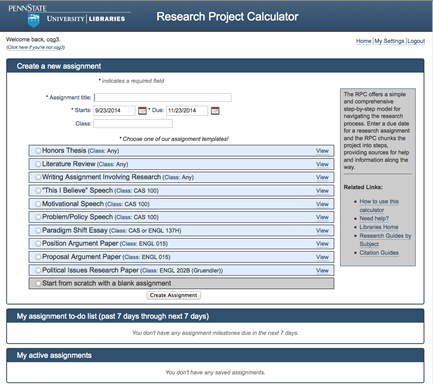Penn State Calculator Guides Students Through Research Projects
- By Dian Schaffhauser
- 09/23/14
Students at Pennsylvania State University can access a research project calculator that helps them navigate the research process. First introduced in 2012, the calculator is based on an open source project called the Assignment Calculator developed at the University of Minnesota Libraries and most recently customized for Penn State users by the institution's Web Tools and Discoverability Group.
The calculator allows the student to enter a due date for a research project. The utility then breaks the project into steps and provides sources for help and information along the way. Two days ahead of when each step should be completed, the tool automatically sends a reminder email to the student with guidance from the librarians and a list of resources for that phase of the work.
| |

Penn State's research project calculator breaks projects into steps and sources for information and help throughout the project. |
|
The program can be customized to add new assignments, send email reminders and add notes as well as share the calculator with others working together in a group project.
It has also been customized for specific purposes. Library personnel worked with the university's English and Communication Arts and Sciences instructors to create assignments in the calculator that align with those that are given in two of Penn State's required courses: Rhetoric and Composition and Effective Speech. Also, recently, a template was added to give honors students help in completing their theses.
"Students really love this tool," said Emily Rimland, information literacy librarian and learning technologies coordinator. "It's a great time management helper."
Its use "effectively extends our reach to students," Rimland noted. "By emailing the student reminders about milestones related to the assignment, along with information about how to complete that particular step, we are able to continue to help students outside the classroom. The info in the email reminders points back to library or university resources that will help them, so they don't have to remember or record everything from class — rather it's there at their point of need.
Students are introduced to the calculator during an annual libraries open house, during research sessions provided to students by librarians, by course instructors or advisors, through the libraries' Web site and in one-on-one research consultations with students by librarians. Currently, the number of accounts is about 2,700.
About the Author
Dian Schaffhauser is a former senior contributing editor for 1105 Media's education publications THE Journal, Campus Technology and Spaces4Learning.